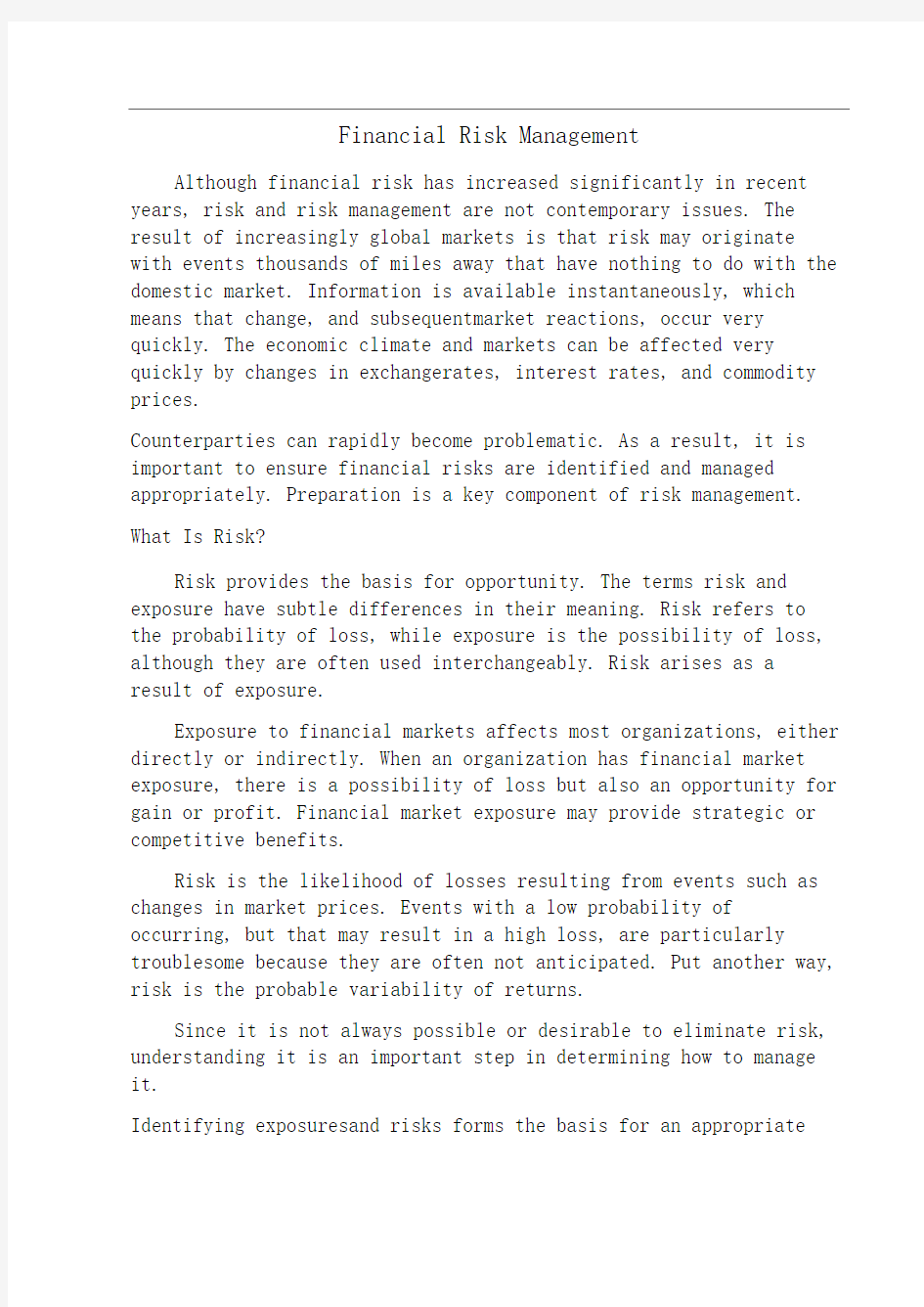财务风险管理外文文献翻译译文

- 1、下载文档前请自行甄别文档内容的完整性,平台不提供额外的编辑、内容补充、找答案等附加服务。
- 2、"仅部分预览"的文档,不可在线预览部分如存在完整性等问题,可反馈申请退款(可完整预览的文档不适用该条件!)。
- 3、如文档侵犯您的权益,请联系客服反馈,我们会尽快为您处理(人工客服工作时间:9:00-18:30)。
Financial Risk Management
Although financial risk has increased significantly in recent years, risk and risk management are not contemporary issues. The result of increasingly global markets is that risk may originate
with events thousands of miles away that have nothing to do with the domestic market. Information is available instantaneously, which means that change, and subsequentmarket reactions, occur very quickly. The economic climate and markets can be affected very quickly by changes in exchangerates, interest rates, and commodity prices.
Counterparties can rapidly become problematic. As a result, it is important to ensure financial risks are identified and managed appropriately. Preparation is a key component of risk management.
What Is Risk?
Risk provides the basis for opportunity. The terms risk and exposure have subtle differences in their meaning. Risk refers to the probability of loss, while exposure is the possibility of loss, although they are often used interchangeably. Risk arises as a
result of exposure.
Exposure to financial markets affects most organizations, either directly or indirectly. When an organization has financial market exposure, there is a possibility of loss but also an opportunity for gain or profit. Financial market exposure may provide strategic or competitive benefits.
Risk is the likelihood of losses resulting from events such as changes in market prices. Events with a low probability of occurring, but that may result in a high loss, are particularly troublesome because they are often not anticipated. Put another way, risk is the probable variability of returns.
Since it is not always possible or desirable to eliminate risk, understanding it is an important step in determining how to manage it.
Identifying exposuresand risks forms the basis for an appropriate
financial risk management strategy.
How Does Financial Risk?
Financial risk arises through countless transactions of a financial nature, including sales and purchases, investments and loans, and various other business activities. It can arise as a
result of legal transactions, new projects, mergers and acquisitions, debt financing, the energy component of costs, or through the activities of management, stakeholders, competitors, foreign governments, or weather. When financial prices change dramatically, it can increase costs, reduce revenues, or otherwise adversely impact the profitability of an organization. Financial fluctuations may make it more difficult to plan and budget, price goods and services, and allocate capital.
There are three main sources of financial risk:
1.Financial risks arising from an organization e'xpsosure to changes in market prices, such as interest rates, exchange rates, and commodity prices.
2.Financial risks arising from the actions of, and transactions with, other organizations such as vendors, customers, and counterparties in derivatives transactions
3.Financial risks resulting from internal actions or failures of the organization, particularly people, processes, and systems
What Is Financial Risk Management?
Financial risk management is a process to deal with the uncertainties resulting from financial markets. It involves assessingthe financial risks facing an organization and developing management strategies consistent with internal priorities and policies. Addressing financial risks proactively may provide an organization with a competitive advantage. It also ensures that management, operational staff, stakeholders, and the board of directors are in agreement on key issues of risk.
Managing financial risk necessitatesmaking organizational decisions about risks that are acceptable versus those that are not.
